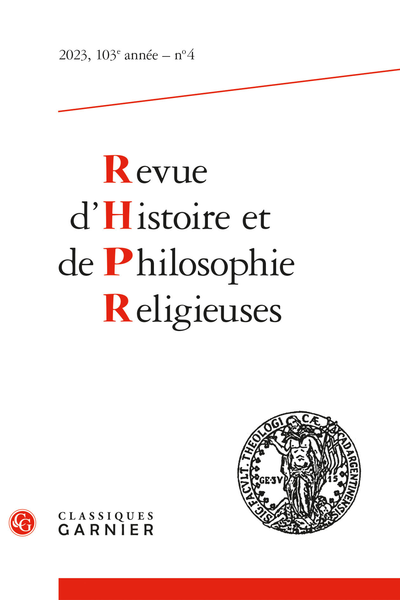
Résumés
- Type de publication : Article de revue
- Revue : Revue d'Histoire et de Philosophie Religieuses
2023 – 4, 103e année, n° 4. varia - Pages : 553 à 555
- Revue : Revue d'Histoire et de Philosophie religieuses
- Thème CLIL : 4046 -- RELIGION -- Christianisme -- Théologie
- EAN : 9782406160724
- ISBN : 978-2-406-16072-4
- ISSN : 2269-479X
- DOI : 10.48611/isbn.978-2-406-16072-4.p.0145
- Éditeur : Classiques Garnier
- Mise en ligne : 27/12/2023
- Périodicité : Trimestrielle
- Langues : Français, Anglais
résumés/abstracts
Alfred Marx, « Le rayon vert de la cathédrale de Strasbourg. Une exégèse optique de Gn 49,10 »
Dans la cathédrale de Strasbourg, à chaque équinoxe, un rayon de couleur verte traverse le pied du vitrail de Juda et se projette sur la représentation du Christ en croix, sculptée sur la chaire. On se propose de démontrer qu’il s’agit là d’une transposition optique d’une exégèse chrétienne de la bénédiction de Jacob sur Juda, en Gn 49,8-12, telle qu’on la trouve, à la suite des écrits juifs de la période intertestamentaire, dans la tradition chrétienne, et notamment chez les Pères apostoliques.
Mots-clés : Genèse 49,8-12, prophéties messianiques, cathédrale de Strasbourg, Shiloh, rayon vert.
Alfred Marx, “The Green Ray at Strasbourg Cathedral. An Optical Exegesis of Gen 49:10”
In Strasbourg cathedral, at each equinox, a green ray of sunlight crosses the foot of the Judah window and is projected onto the representation of Christ on cross sculpted on the pulpit. We propose to demonstrate that this is an optical transposition of a Christian exegesis of Jacob ’ s blessing on Judah (Gen 49:8-12), as found in Christian tradition, especially in the Apostolic Fathers, following the Jewish writings of the intertestamental period.
Keywords: Genesis 49:8-12, messianic prophecies, Strasbourg cathedral, Shiloh, green ray.
Gilbert Vincent, « Penser plus, imaginer mieux. Mémoire et religion chez Gabriel Gauny »
Témoin direct de la condition prolétarienne, Gabriel Gauny compte parmi les farouches défenseurs des trois valeurs constitutives de la devise républicaine française. Pour lui comme pour des penseurs tels que Saint-Simon, Pierre Leroux, Proudhon ou Quinet, la question de la généalogie de ces valeurs est de première importance : le projet d’une 554société nouvelle manquerait de légitimité, à leurs yeux, s’il ne s’autorisait pas de la tradition chrétienne. Mais de quel christianisme s’agit-il ?
Mots-clés : liberté, fraternité, solidarité, tradition, religion, mémoire, saint-simonisme, nature, marche, insurrection.
Gilbert Vincent, “Think More, Imagine Better. Memory and Religion in Gabriel Gauny”
Gabriel Gauny, a first-hand witness to the proletarian condition, is one of the fiercest defenders of the three values that make up the French Republican motto. For him, as for thinkers such as Saint-Simon, Pierre Leroux, Proudhon and Quinet, the question of the genealogy of these values is of the utmost importance: the project of a new society would lack legitimacy, in their eyes, if it did not draw on the Christian tradition. But what kind of Christianity are we talking about?
Keywords: freedom, fraternity, solidarity, tradition, religion, memory, Saint-Simonism, nature, the march, insurrection.
Frédéric Rognon, « Penser l’amour en dialectique. II. Les paradoxes d’une réception »
La réception de la pensée kierkegaardienne de l’amour est foncièrement hétérogène et paradoxale. La plupart des commentaires des Œuvres de l’amour n’en ont pas perçu le fondement dialectique ou, pour ceux qui s’en sont approchés, n’ont pas saisi le double caractère de cette dialectique : cathartique et agonistique. Un parcours à travers les principaux moments de cette réception permet d’affiner l’analyse de cette œuvre, en cohérence avec l’anthropologie existentielle de Kierkegaard.
Mots-clés : Kierkegaard, amour, réception, dialectique, paradoxe, cathartique, agonistique.
Frédéric Rognon, “Dialectical Thinking about Love. II. The Paradoxes of a Reception”
The reception of Kierkegaardian thought on love is fundamentally heterogeneous and paradoxical. Most commentaries on the Works of Love have failed to perceive its dialectical basis or, for those who have come close, have failed to grasp the dual character of this dialectic: cathartic and agonistic. A journey through the main moments of this reception allows us to refine our analysis of this work, in line with Kierkegaard’s existential anthropology.
Keywords: Kierkegaard, love, reception, dialectic, paradox, cathartic, agonistic.
555Antoine Altieri, « Monde contemporain et transcendance. Tangible contre tactile »
Prenant acte du phénomène nouveau qu’est l’occultation du monde réel par les techniques modernes de communication, et d’un règne de l’immanence radicale et du seul visible, cette étude, qui promeut le « tangible » face au « tactile », s’interroge (à partir notamment de Heidegger) sur la modalité d’être fondamentale dont ces techniques sont l’ultime avatar et lui oppose une expérience de la transcendance où l’invisible a sa place, mais en dépendance du monde « réel » : l’expérience d’autrui.
Mots-clés : technique, science, autrui, toucher, chair, visible, invisible.
Antoine Altieri, “The Contemporary World and Transcendence. Tangible versus Tactile”
Taking note of the new phenomenon of the occultation of the real world by modern communication techniques, and of a supremacy of radical immanence and of the solely visible, this study, which promotes the “tangible” in the face of the “tactile”, examines the fundamental modality of being of which these techniques are the ultimate avatar, and contrasts it with an experience of transcendence in which the invisible has its place, but in dependence on the “real” world: the experience of others.
Keywords: technique, science, others, touch, flesh, visible, invisible.